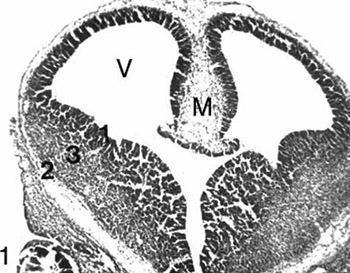Development of the rat telencephalon-volumetric analysis
DOI:
https://doi.org/10.17305/bjbms.2004.3375Keywords:
rat telencephalon, development, stereologyAbstract
With regard to intensive morphometric changes, morphometry as a method is mainly used for histogenetic studies of brain development in normal and experimental conditions. The aim of our study was to quantitatively analyse morphological parameters of the rat telencephalon during embryonic development. The investigation was carried out on semithin serial sections of rat brain from embryonic days 12 to 15. The volume densities (VV) of the lateral ventricles, the telencephalic neuroepithelium and the surrounding mesenchyme have been analysed stereologically and compared in examined embryonic stages. The neuroepithelial volume density was the smallest (28%) at E13 and the biggest (44%) at E15 (p<0.0005). The mesenchymal volume density was the smallest (32%) at E13 and the biggest (48%) at E14 (p<0.0005). The volume density of lateral ventricles was the biggest (40%) at E13 and the smallest (14%) at E15 (p<0.0005). Neurostereological methods have been making a very valuable contribution to neuroscience over recent years. We have used unbiased stereological counting methods to obtain objective quantitative parameters which show relations between some parts of rat embryonic telencephalon examined during its normal development.
Citations
Downloads

Downloads
Published
How to Cite
Accepted 2018-03-15
Published 2004-08-20









